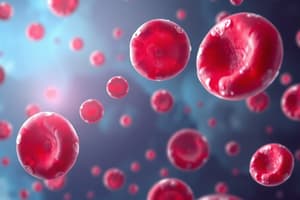Podcast
Questions and Answers
Which agent is known to stimulate fetal hemoglobin (HbF) expression significantly?
Which agent is known to stimulate fetal hemoglobin (HbF) expression significantly?
- Imatinib
- Decitabine (correct)
- Arsenic Trioxide
- Thalidomide
What is the mechanism by which 5-azacytidine increases fetal hemoglobin production?
What is the mechanism by which 5-azacytidine increases fetal hemoglobin production?
- Direct gene activation
- Protein synthesis inhibition
- Epigenetic modification (correct)
- Reduction in erythropoietin levels
What therapeutic goal is associated with increasing fetal hemoglobin (HbF) levels?
What therapeutic goal is associated with increasing fetal hemoglobin (HbF) levels?
- Lowering blood pressure
- Reducing sickle cell crises (correct)
- Enhancing oxygen delivery
- Decreasing iron overload
How do butyrates function in relation to fetal hemoglobin?
How do butyrates function in relation to fetal hemoglobin?
Which of the following conditions may lead to low neutrophil counts or neutropenia?
Which of the following conditions may lead to low neutrophil counts or neutropenia?
What fetal hemoglobin (HbF) level is suggested to make a patient with sickle cell anemia asymptomatic?
What fetal hemoglobin (HbF) level is suggested to make a patient with sickle cell anemia asymptomatic?
Which statement about the action of 5-azacytidine is correct?
Which statement about the action of 5-azacytidine is correct?
Which therapeutic agent is often used to address sickle cell disease in adults by inducing HbF production?
Which therapeutic agent is often used to address sickle cell disease in adults by inducing HbF production?
What is the primary indication for agents that induce fetal hemoglobin (HbF)?
What is the primary indication for agents that induce fetal hemoglobin (HbF)?
At what age do patients with sickle cell disease begin to show symptomatic manifestations?
At what age do patients with sickle cell disease begin to show symptomatic manifestations?
What is the typical level of fetal hemoglobin (HbF) in adults with sickle cell disease?
What is the typical level of fetal hemoglobin (HbF) in adults with sickle cell disease?
What role does eumelanin play in influencing the clinical manifestations of sickle cell disease?
What role does eumelanin play in influencing the clinical manifestations of sickle cell disease?
What is a consequence of fetal globin gene expression persisting in newborns with sickle cell disease?
What is a consequence of fetal globin gene expression persisting in newborns with sickle cell disease?
Why are butyrates not effective in inducing HbF if the baseline HbF is less than 1%?
Why are butyrates not effective in inducing HbF if the baseline HbF is less than 1%?
What does the increased levels of HbF in children imply for the treatment of sickle cell disease?
What does the increased levels of HbF in children imply for the treatment of sickle cell disease?
What is a potential effect of agents that induce fetal hemoglobin (HbF) on sickle cell disease clinical outcomes?
What is a potential effect of agents that induce fetal hemoglobin (HbF) on sickle cell disease clinical outcomes?
What is the major effect of hydroxyurea in the treatment of sickle cell anemia?
What is the major effect of hydroxyurea in the treatment of sickle cell anemia?
Which agents are known to stimulate leukocyte production?
Which agents are known to stimulate leukocyte production?
How does ribonucleotide reductase relate to the treatment of sickle cell anemia?
How does ribonucleotide reductase relate to the treatment of sickle cell anemia?
What role does fetal hemoglobin (HbF) play in sickle cell disease management?
What role does fetal hemoglobin (HbF) play in sickle cell disease management?
Which of the following statements about azacytidine is true?
Which of the following statements about azacytidine is true?
What is a less common cause of neutropenia mentioned in the treatment considerations?
What is a less common cause of neutropenia mentioned in the treatment considerations?
Which drug was primarily used in the 1990s for the treatment of sickle cell anemia?
Which drug was primarily used in the 1990s for the treatment of sickle cell anemia?
Which condition may accompany leukemia and is associated with myelosuppression?
Which condition may accompany leukemia and is associated with myelosuppression?
Flashcards
Fetal Hemoglobin (HbF)
Fetal Hemoglobin (HbF)
A type of hemoglobin found in newborns and infants, which can persist for months after birth.
Sickle Cell Disease
Sickle Cell Disease
A genetic disorder causing abnormal red blood cells and episodes of pain.
HbS
HbS
Sickle hemoglobin, a form of hemoglobin that causes sickle cell disease.
Acute Pain Crises
Acute Pain Crises
Signup and view all the flashcards
Hemolytic Anemia
Hemolytic Anemia
Signup and view all the flashcards
Fetal Globin Gene Expression
Fetal Globin Gene Expression
Signup and view all the flashcards
HbF Levels in Sickle Cell
HbF Levels in Sickle Cell
Signup and view all the flashcards
Epigenetic Mechanisms
Epigenetic Mechanisms
Signup and view all the flashcards
Sickle Cell Anemia
Sickle Cell Anemia
Signup and view all the flashcards
5-azacytidine
5-azacytidine
Signup and view all the flashcards
DNA Methylation
DNA Methylation
Signup and view all the flashcards
Butyrates
Butyrates
Signup and view all the flashcards
Myeloid Growth Factors
Myeloid Growth Factors
Signup and view all the flashcards
Neutropenia/Neutrophilia
Neutropenia/Neutrophilia
Signup and view all the flashcards
What inhibits cell division in hydroxyurea?
What inhibits cell division in hydroxyurea?
Signup and view all the flashcards
Hydroxyurea's impact on sickle cell crises
Hydroxyurea's impact on sickle cell crises
Signup and view all the flashcards
What is ribonucleotide reductase's role?
What is ribonucleotide reductase's role?
Signup and view all the flashcards
Neutropenia: Potential causes
Neutropenia: Potential causes
Signup and view all the flashcards
How do Filgrastim and Sargramostim work?
How do Filgrastim and Sargramostim work?
Signup and view all the flashcards
What is the difference between azacytidine and decitabine?
What is the difference between azacytidine and decitabine?
Signup and view all the flashcards
Decitabine
Decitabine
Signup and view all the flashcards
Study Notes
Pharmacology I: Hematinics & Hematopoietic Drugs
- Hematinics are vitamins, nutraceuticals, or dietary factors vital for hemoglobin (Hb) synthesis or erythrocyte production.
- Iron deficiency anemia (IDA) is the most common nutritional deficiency globally, affecting up to 1 billion people.
- IDA results from insufficient dietary iron intake, impacting labor capacity, growth, and learning in children and causing cyclical menstrual issues in women.
- Each pregnancy results in 500 mg iron loss, necessitating supplementation.
- Iron absorption is regulated by absorptive enterocytes in the small intestine.
- Optimal iron absorption from a typical diet is 1 mg (10% of 10-20 mg daily intake).
- Iron is incorporated into hemoglobin (2.5 g in males, 1.7 g in females).
- Iron is stored as ferritin (intracellularly) and hemosiderin (partially oxidized ferritin).
- Non-heme iron (ferric) needs conversion to ferrous form for absorption from plant sources.
- Dietary sources of iron include beef, chicken, oysters, shrimp, tuna, black-strap molasses, raisin bran cereal, raisins, prune juice, prunes, potatoes (with skin), kidney beans, lentils, tofu, and cashew nuts.
- Women require more iron due to menstruation, with 50% of pregnant women showing iron deficiency.
- Megaloblastic anemia arises from vitamin B12 (cobalamin) or folate (vitamin B9) deficiency.
- Vitamin B12 deficiency correlates with pernicious anemia (due to intrinsic factor absence leading to poor absorption).
- Folate deficiency is associated with alcoholism, liver disease, malabsorption, and some medications.
- Increased intake of folic acid during pregnancy helps prevent neural tube defects in fetuses.
- Parenteral iron therapy is necessary if oral iron is poorly tolerated or required quickly.
- Oral iron therapy involves simple or complex iron compounds.
- Oral iron is absorbed in the gut, but absorption decreases as hemoglobin levels rise (negative feedback loop).
- 5-azacytidine and hydroxyurea stimulate fetal hemoglobin (HbF) production, improving sickle cell anemia symptoms.
- Butyrates prevent the switching from HbF to hemoglobin S (HbS).
- Agents that stimulate erythropoiesis include erythropoietin (EPO).
- EPO increases red blood cell (RBC) production and is used to treat anemia.
- EPO has a role in glial and neuronal cell survival.
- Darbepoetin alfa is a longer-acting EPO analogue.
- Agents that stimulate leukocyte production (e.g., filgrastim, sargramostim) are used to increase white blood cell counts.
- Platelet-producing agents (e.g., rhTPO, eltrombopag, romiplastin, oprevelkin) are used to address low platelet counts.
Hematopoietic Growth Factors
- Hematopoietic growth factors stimulate RBC production, helping treat anemia.
- Erythropoietin (EPO) is used to combat different types of anemia.
Iron Deficiency Anemia (IDA)
- IDA occurs when insufficient iron is absorbed, leading to decreased hemoglobin levels.
- Symptoms of IDA include fatigue, pallor, and cold intolerance.
- Clinical signs of IDA include microcytic, hypochromic anemia.
- Diagnosed through serum ferritin, total iron-binding capacity (TIBC), and serum iron (SI) levels.
Megaloblastic Anemia
- Megaloblastic anemia results from vitamin B12 or folate deficiency.
- This impacts DNA synthesis and leads to larger than normal RBCs.
- Vitamin B12 is essential for methionine and tetrahydrofolate synthesis.
- Folate is essential for DNA synthesis in the body.
Studying That Suits You
Use AI to generate personalized quizzes and flashcards to suit your learning preferences.




